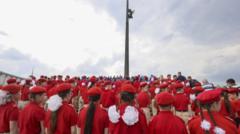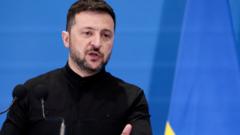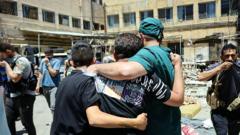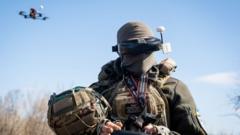The ongoing conflict intensifies as intense bombardments affect numerous cities, leaving devastation in their wake.
Wave of Destruction: Russia Launches Intense Air Assault on Ukraine
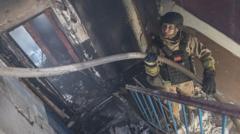
Wave of Destruction: Russia Launches Intense Air Assault on Ukraine
Overnight airstrikes in Ukraine lead to multiple casualties and widespread damage.
Buildings across Ukraine appeared engulfed in flames after a relentless wave of Russian air strikes took place, leading to tragic consequences that resulted in at least three fatalities. Governor Sergiy Lysak reported that two individuals lost their lives in the Dnipropetrovsk region, while a woman succumbed to her injuries after being saved from a burning apartment in the port city of Odesa. President Volodymyr Zelensky shared that the overnight attacks targeted ten regions, affecting several urban areas.
Ukraine's military confirmed the deployment of over 340 drones—both explosive and dummy variants—alongside 35 cruise and ballistic missiles during the siege. While they reported successfully intercepting 90% of these threats, more than 30 managed to breach Ukrainian defenses. Odesa was one of the hardest-hit cities, where a missile strike caused a fire that trapped residents in their homes. Emergency responders managed to save five individuals, including the woman who later passed away from her injuries. In total, six other people were injured during the assault.
Describing the situation in Pavlohrad, Lysak characterized the night as resembling “hell” due to the intense and sustained bombardments, which he called the most significant offensive the city had experienced. A mix of industrial, residential, and civic sites became targets during the strikes, highlighting the expansion of Russia's military aim beyond purely military installations. Zelensky noted that vital infrastructure had been damaged here.
Other regions were not spared, as Sumy faced strikes that crippled power supplies to thousands. The nearby town of Shostka also reported targeted hits, with smoke rising from the scene of one incident. Zelensky emphasized the urgent need for strengthening air defenses and producing interceptor drones domestically, in light of international support for military supplies from allies, including the recent provision of Patriot air defense systems.
On the Russian side, defense officials claimed to have downed over 70 Ukrainian drones, predominantly over the Rostov, Moscow, and Bryansk regions. Slyusar, acting governor of Rostov, noted local damages caused by falling debris and temporary power outages due to the large-scale attacks.
Meanwhile, the frontline narrative sees Russian forces intensifying their offensive on Pokrovsk in the Donetsk region. Ukraine's military leader, Oleksandr Syrskyi, acknowledged mounting challenges but asserted their resolve to hold the line against the aggressors who continue to seek encirclement of the town. The conflict rages on as both sides brace themselves for further escalations.
Ukraine's military confirmed the deployment of over 340 drones—both explosive and dummy variants—alongside 35 cruise and ballistic missiles during the siege. While they reported successfully intercepting 90% of these threats, more than 30 managed to breach Ukrainian defenses. Odesa was one of the hardest-hit cities, where a missile strike caused a fire that trapped residents in their homes. Emergency responders managed to save five individuals, including the woman who later passed away from her injuries. In total, six other people were injured during the assault.
Describing the situation in Pavlohrad, Lysak characterized the night as resembling “hell” due to the intense and sustained bombardments, which he called the most significant offensive the city had experienced. A mix of industrial, residential, and civic sites became targets during the strikes, highlighting the expansion of Russia's military aim beyond purely military installations. Zelensky noted that vital infrastructure had been damaged here.
Other regions were not spared, as Sumy faced strikes that crippled power supplies to thousands. The nearby town of Shostka also reported targeted hits, with smoke rising from the scene of one incident. Zelensky emphasized the urgent need for strengthening air defenses and producing interceptor drones domestically, in light of international support for military supplies from allies, including the recent provision of Patriot air defense systems.
On the Russian side, defense officials claimed to have downed over 70 Ukrainian drones, predominantly over the Rostov, Moscow, and Bryansk regions. Slyusar, acting governor of Rostov, noted local damages caused by falling debris and temporary power outages due to the large-scale attacks.
Meanwhile, the frontline narrative sees Russian forces intensifying their offensive on Pokrovsk in the Donetsk region. Ukraine's military leader, Oleksandr Syrskyi, acknowledged mounting challenges but asserted their resolve to hold the line against the aggressors who continue to seek encirclement of the town. The conflict rages on as both sides brace themselves for further escalations.

